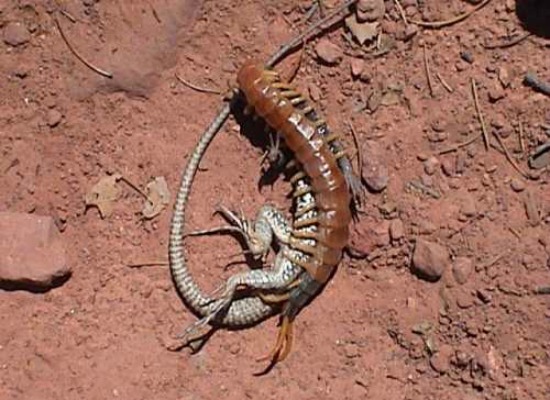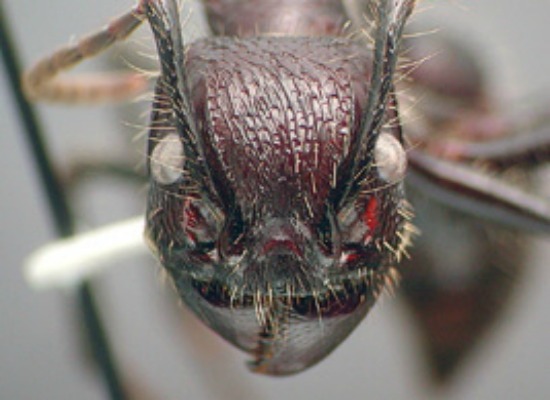The Nastiest Critters Lurking Outside Your Tent
The bite of a Goliath bird-eater is hardly worse than a bee sting—-but it is among the nastiest things that could skitter across your face in the Amazon
/https://tf-cmsv2-smithsonianmag-media.s3.amazonaws.com/filer/20120508091032ScorpionSMALL.jpg)
Give me a rainstorm in the night, a herd of pigs trampling past, even a bear—but if I’m camping without a tent, spare me the bugs. Because it’s the little things in the woods that creep many of us out the most, and the thing is, not all of them are so little—and worse, some have fangs and a hundred legs. Centipedes that can overpower a snake, spiders a foot wide, rodent-sized scorpions and other creepy crawlers of the forest floor offer good reason to sleep inside a tent. For years, I only camped under the open skies. If it rained, I would wrap up in a tarp or sleep under the awning of a church. But one night in Portugal while reading a book by the light of my headlamp, a huge spider with legs like an imperial walker came dancing onto my tarp and into my lap like a mad dervish. I screamed, panicked, flew home and bought a one-person, three-pound backpacking tent. That doesn’t mean I always use it, but here are a few good reasons why I should:
Deathstalker scorpion (Leiurus quinquestriatus). The deathstalker scorpion just might have the coolest name in the animal kingdom. A Middle East native, it grows to four inches or more in length, brandishes a horrifying pair of pincers and lives up to its name. Often described as “very aggressive,” it hammers its stinger into many people every year, killing several. Most victims, though, just suffer extreme pain in the region of the bite, along with drowsiness, fatigue, splitting headaches and joint pain, with symptoms sometimes persisting for months. Meanwhile, most scorpions are less dangerous than simply creepy. David Quammen—an admitted arachnophobe—elaborates on this in his essay See no Evil, published in his 1988 collection The Flight of the Iguana. He writes, “…scorpions are perhaps the most drastically, irredeemably repulsive group of animals on the face of the Earth, even including toy poodles.” Tent, please.
Goliath bird-eating spider (Theraphosa blondi). The biggest of the tarantulas and the world’s largest arachnid, the Goliath bird-eating spider lives in the rainforests of South America. Its legs can span the width of a dinner plate (should it find its way into your kitchen cupboard) and it’s large enough that it can, with ease, kill and eat mice—not to mention birds. The animal’s fangs may be an inch long, and yes, they will inject venom. However, the bite of a Goliath bird-eater is hardly worse than a bee sting to a human—but for campers, do you really think that matters? No way. This beast is among the nastiest things that could skitter across your face in the dark night of the Amazon. Zip up your tent.
Giant desert centipede (Scolopendra heros). On a hot afternoon in September 2003, I was bushwhacking out of the mountains in the Baja California desert not far from La Paz. I fought and kicked my way through the thorns, ducking through tunnels in the brush, and finally made it to the quiet shore of the Sea of Cortez. I plopped down in the sand, my back against against a rock, opened my backpack, and went digging for my mask and snorkel—and then appeared the ugliest monster I’ve ever seen: a seven-inch centipede that came snaking out of the pack, right past my arms and on a trajectory for my face. It was, I’m almost sure, Scolopendra heros. I screamed in a howling panic, leaped from the sand, and went backpedaling into the water, where I fell on my butt and and watched the centipede vanish into a rockpile. This creature, I later was told, is poisonous and can, if it feels especially wicked, bite and deliver venom with its fangs as well as some of its legs. And you want a much, much nastier story? In a documented case in Arizona, a man put a garden hose to his mouth and turned on the faucet to have a drink—and can you guess who came charging out of the nozzle? S. heros scuttled right into his mouth and bit his tongue, leaving him in pain for days.

This giant desert centipede has overpowered and killed a lizard. A tent may block your view of a meteor shower, but it'll keep monsters like this from scuttling into your sleeping bag. Photo courtesy of Cabeza Prieta Natural History Association.
Bullet ant (Paraponera clavata). An inch long and known to jump from trees upon its victims, the bullet ant of Central and South America delivers what is said to be the most painful sting of any arthropod. It hurts like a bullet wound, people say, and the pain may persist for 24 hours. In the ant’s defense, Paraponera clavata is not aggressive unless bothered—so if you get stung, you must have asked for it. The ants also offer fair warning before attacking, emitting a musky odor and an audible “shriek.” If you detect anything of the sort while hiking in the Amazon, turn and run—or just suck it up and experience this phenomenal bite like a man,which is exactly what teenage boys in certain forest cultures do to prove their manhood. Anyway, the bullet ant’s bite rarely kills.
Brazilian wandering spider (Phoneutria fera). Widely considered the most poisonous spider in the world, wandering spiders reportedly hospitalized about 7,000 people in Brazil alone between 1970 and 1980 and may have killed more people than any other arachnid in the world. Phoneutria fera is often regarded as the main offending species, but others of the same genus, including the Brazilian huntsman, have similarly toxic venom. The spiders are known to wander and explore, often hiding in clumps of bananas, and often entering homes to have a nap in the toes of a shoe by the doorstep or a vacant pant leg in the clean laundry pile—and surely a cozy sleeping bag would be a fine dwelling site for a wandering spider. Symptoms of a bite include pain, redness and immobility in the area of the bite. Paralysis and death by asphyxiation may follow. In survivors, tissue affected by the poison may die and rot away. Another bizarre symptom immediately following a bite in men is a painful erection lasting hours and sometimes causing impotence.
Mosquito (Family Culicidae). Consisting of 41 genera and more than 3,500 species in the family Culicidae, mosquitoes may not inspire nightmares or make our skin crawl the way that arachnids can, but what other element of nature so frequently ruins a night of camping? Whether on the boggy tundra, in the blazing desert or in the swamp country, mosquitoes may swarm us in clouds. Even a bona fide house with walls and a roof can’t always protect against mosquitoes, and in parts of the world people sleep with permanent netting over their beds. These insects insect may be the most dangerous, too: in 2003, malaria killed 3 million people—infected thanks to mosquitoes. And these bloodsucking disease vectors dealt me what was one of the most torturous nights of my life while camping (with no tent) on the shore of a mangrove lagoon in Mexico. After about 500 bites, I went stumbling into the village around midnight and pleaded with a bartender for bug spray. He said citrus juice was the most potent mosquito repellent—trick from his grandmother—and he threw a lime at me from his cocktail making tray. It didn’t work. After bite 2,000 or thereabouts I wrapped a towel around my head, jumped in the water and breathed through a snorkel until dawn brought relief.
/https://tf-cmsv2-smithsonianmag-media.s3.amazonaws.com/accounts/headshot/Off-Road-alastair-bland-240.jpg)

/https://tf-cmsv2-smithsonianmag-media.s3.amazonaws.com/accounts/headshot/Off-Road-alastair-bland-240.jpg)